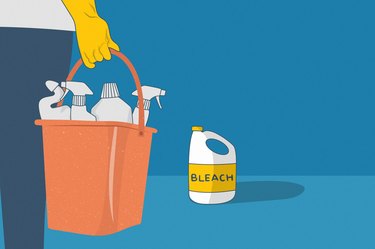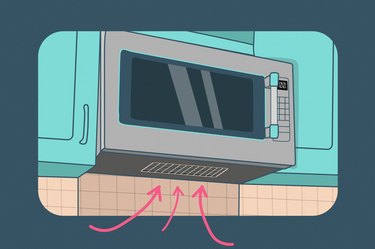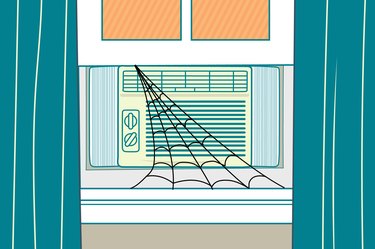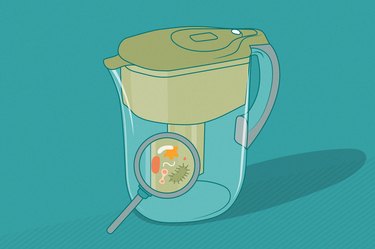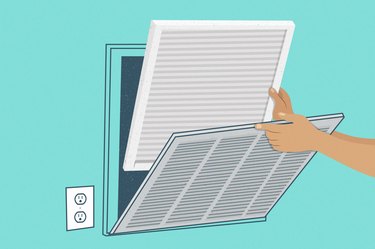
How often to change furnace filters is a classic homeowner question. Technically, the answer is every 1 to 3 months during the heating season. If you're way off this schedule or you never change your furnace filter, chances are your indoor air is dirtier than it should be and your furnace is working harder than it needs to.
A furnace filter has one primary job: trapping dust and other tiny debris to keep it out of the insides of your furnace. The filter also keeps that same dust and debris from blowing through your ductwork and back into the house. In other words, it takes it out of circulation.
Video of the Day
Video of the Day
A dirty, clogged air filter does a poor job of cleaning the air and — much worse — it restricts the airflow through your HVAC system. That means your furnace won't heat your house as well as it could, it'll cost you more to run and it'll likely need repair or replacement sooner that it should.
In my two decades of helping people repair and remodel their homes, I've seen some pretty bad cases of furnace filter neglect as well as some expensive consequences. Here are all the reasons why it's actually quite bad to never change your furnace filter, or even to not change it enough.
How Your Furnace Filter Works
To understand why it's important to change your filter, it helps to know exactly what your furnace does. A furnace is a type of "forced-air" heating system. It has a powerful blower motor and fan that forces air through the furnace, down the outgoing ducts (called supply ducts) and out through the heating registers in the rooms of your home.
Like all fans, the furnace blower doesn't create air; it just moves air from one place to another. As it's forcing air into the furnace, it's simultaneously sucking air out of the house, through the incoming ducts (called return ducts) and back into the furnace.
All that circulating air passes through the furnace filter right before it enters the blower compartment inside the furnace. As everyone has observed from watching sunbeams coming through a window, there's a lot of stuff floating in the air: dust, pollen, pet hair, etc. That's what gets stuck in the furnace filter.
Once a filter gets really dirty, it becomes more of a barrier than a filter, and dirty air can get around it and into the furnace. There, the air contaminants collect on the blower motor and fan and inside the heat exchanger, where the air gets heated before it's shipped out to the supply ducts.
The combination of restricted airflow and dirty air decreases energy efficiency and increases wear and tear on the furnace — which, along with the air conditioner, is probably the most expensive piece of equipment in your house. Buildup inside the furnace is a common cause of a furnace overheating and shutting down.
Can a Dirty Furnace Filter Make Allergies or Asthma Worse?
By trapping airborne particles like dust, dander and hair, furnace filters help to remove common allergens and irritants from your indoor air. And because dust mites and mold both eat and travel on airborne particles, a dirty furnace filter can aggravate symptoms in two ways: It fails to capture particles, and it provides a food source for these irritants.
"Dirty filters should be cleaned [or replaced] regularly, as they can grow dust mites and mold, which then in turn can cause allergies or asthma," Purvi Parikh, MD, an allergist/immunologist with the Allergy & Asthma Network, tells LIVESTRONG.com.
If you suffer from allergies or other conditions related to indoor air pollution, it's important to understand that a furnace filter cannot purify your indoor air; it merely helps to reduce airborne particles, primarily to keep them out of the furnace and ducts.
The performance, or efficiency, of filters varies widely (more on that below), but even the best furnace filters help to clean your air only when the furnace is running.
In addition to regularly replacing or cleaning the furnace filter, "a HEPA [high-efficiency particulate air] purifier can help further cleanse the air of allergens, irritants, etc.," Dr. Parikh says. "The bedroom is the most important room to keep free of irritants and allergens."
It's also important to note that a furnace filter does not protect a household from carbon monoxide (CO), a deadly, odorless and colorless gas that is a byproduct of burning natural gas or propane, as most furnaces do.
With a fuel-fired (gas or propane) furnace, CO can enter a home through a cracked heat exchanger (where the burners' heat is transferred to the air) or through a breech or blockage in the furnace's exhaust flue.
"A carbon monoxide detector should be in everyone's home as well," Dr. Parikh says. At the very least, every home with a fuel-fired furnace or other appliance should have a CO alarm inside or near the outside of each sleeping room, according to the International Residential Code (IRC).
How Efficient Is Your Furnace Filter? Check the MERV Rating
A MERV rating is a number printed on air filters. MERV means minimum efficiency reporting value, and it basically tells you how well the filter captures particles — you might say how "fine" it is.
MERV ratings range from 1 to 16 for standard filters. The higher the number, the finer the filter. The Environmental Protection Agency (EPA) has a simple MERV rating chart that gives you the sizes and amounts of particles that are captured at each MERV rating level. There are also HEPA filters with MERV ratings of 17 to 20.
The topic of filter efficiency can get pretty technical and even controversial, but it really comes down to two questions:
- How much do you want to filter your air?
- What kind of filter is best for your furnace?
Answering the first question may require a compromise. Filters at the high end of the rating scale — MERV 14 to 16 — capture the most particles, but they can also be the most restrictive of airflow, making your furnace work harder and possibly limiting circulation throughout the house. Those at the lower end of the scale — MERV 6 and below — let air flow through freely, but they also stop a lot fewer particles.
For many households, a mid-range filter of MERV 7 to 13 is the sweet spot. These can do nearly as good a job at removing particles as a HEPA filter, according to the EPA. But if indoor air quality is an important consideration for you or a family member, talk to a doctor about making your air as clean as possible. This may involve using more efficient furnace filters and/or using air purifiers or installing an HVAC filtration system.
Answering the second question is easy: Consult your furnace owner's manual or contact the manufacturer to learn about the recommended filter for your furnace model.
Tips for Replacing Your Furnace Filter
Checking and replacing the filter is an easy DIY job on most furnaces, but the exact steps to follow are specific to the furnace model. That said, there are a few basic tips that apply to almost every furnace with a standard filter.
First, turn down the heat or turn the furnace off at the thermostat so the system doesn't kick on while you're checking or changing the filter. And remember: Check your furnace filter once a month and replace as needed (typically every 1 to 3 months).
Before putting in a new filter (or reinstalling an old clean-enough filter), make sure the filter is facing the right direction: There's an arrow and the words "Air Flow" on the filter; the arrow should point toward the furnace.
When buying filters, choose products with a MERV rating that is appropriate for your furnace and home environment. This may take a bit of research and experimenting with different filters.
Finally, don't make the rookie mistake of buying one filter at a time. If you do, you'll have to go to the store every time you need to replace the filter, and chances are you'll put it off and live with a dirty filter instead. It's best to buy enough to get you through the entire heating (or cooling) season at once.
So, How Bad Is It Really to Never Change Your Furnace Filter?
Never changing your furnace filter would be bad for your indoor air quality at best — and possibly catastrophic for your furnace at worst. Even changing the filter too infrequently will head you in the same direction.
To summarize, here are five reasons why it's bad not to change your furnace filter:
- Airflow is restricted throughout your HVAC system.
- Dirty air gets into the furnace and ducts.
- Indoor air quality suffers.
- Your furnace goes through unnecessary wear and tear.
- Energy efficiency is reduced.
To avoid unnecessary problems, try to follow this simple rule of thumb for how often to change furnace filters: Check your filter once a month during the heating season, and replace it whenever it's dirty. Do the same during the summer if you have air conditioning.
Typically, a filter needs to be replaced every 1 to 3 months, depending on the household conditions and how much you've been running the furnace (or AC), according to Carrier, a leading manufacturer of furnaces and other home HVAC equipment.
Try this pro tip: At the beginning of the heating season, buy five new filters. Put one in right away before you fire up the furnace for the first time. You'll start the season with a clean filter and have four replacement filters to get you through the winter.
Is this an emergency? If you are experiencing serious medical symptoms, please see the National Library of Medicine’s list of signs you need emergency medical attention or call 911.

